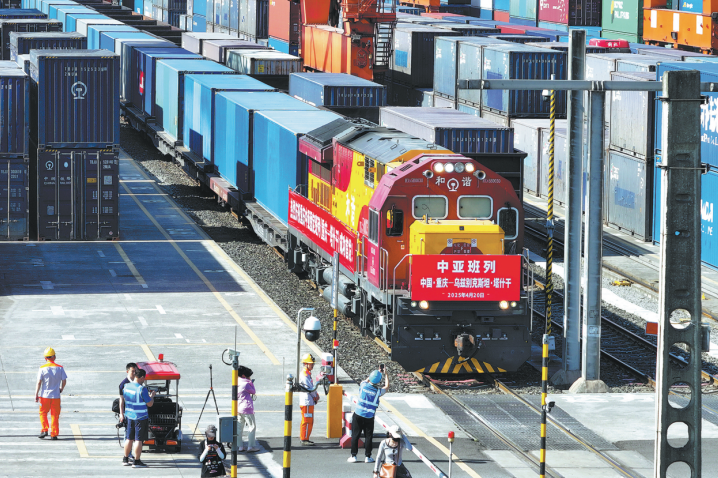Local government debt risks subside on effective resolution moves
By Zhang Xiaojing | China Daily | Updated: 2024-09-02 09:26
China's economic growth and the expansion of its debt are intricately intertwined, with the synchronized growth of debt and asset accumulation exemplifying the unique characteristics of the country's economic development.
A comprehensive understanding of China's national conditions is essential for discussing local debt risks and the effectiveness of debt resolution measures.
Since the 18th National Congress of the Communist Party of China, the central government has placed significant emphasis on addressing local government debt issues, particularly the hidden debt risks associated with financing vehicles.
In July 2023, during a meeting of the Political Bureau of the CPC Central Committee, a comprehensive plan for debt resolution was proposed, aiming to effectively prevent and mitigate local government debt risks.
Over the course of a year, notable progress has been made in debt resolution efforts, effectively curbing the uncontrolled expansion of hidden debt risks. The government debt structure has been optimized, with measures in place to alleviate interest payment pressures.
Furthermore, the restructuring and transformation of local government financing vehicles have been initiated, contributing to overall improvement in the government debt management mechanism.
The current approach to debt resolution by the central government focuses on three key points, aiming to address local government debt risks and promote financial stability.
With both immediate and future benefits in mind, a combination of short-term and long-term measures will be employed. To alleviate short-term liquidity pressures, the central government has introduced special refinancing bonds and emergency liquidity financial instruments.
In addition, financial institutions are being guided to restructure and refinance existing debt in accordance with market-oriented and rule-of-law principles. This involves extending the maturity of debt and reducing interest costs, which helps alleviate the burden of debt repayment for local governments.
Meanwhile, China has adopted a dual approach, combining control and facilitation measures, to effectively address local government debt risks and maintain stability in infrastructure investment.
To curb the expansion of hidden debt, the central government has taken decisive measures to restrict the increase in hidden debts. In the 12 key provinces with a focus on debt resolution, the growth of new debt and project construction has been limited.
In parallel, the government aims to optimize debt resolution and stabilize infrastructure investment by proactively facilitating the issuance and utilization of ultra-long-term special government bonds and medium- to long-term special bonds.
While actively resolving the debt stock, the government is also planning to establish a long-term mechanism to prevent and mitigate local government debt risks. This includes the development of a government debt management framework that aligns with high-quality development objectives and the optimization of debt structures for both central and local governments.
Local governments across China are actively implementing the central government's decisions and deploying precise, well-focused and region-specific plans to address debt challenges. Five main approaches have been adopted by local governments to address their respective debt situations.
First, local governments are striving to secure support from the central government in debt resolution. This includes issuing special refinancing bonds and applying to be included in the pilot list for county-level debt resolution programs.
Second, local governments are employing various methods to broaden their sources of debt resolution funds. These methods include increasing revenue, reducing expenditures, leveraging existing assets and resources, and exploring asset securitization.
Third, local governments are engaging in negotiations with financial institutions to optimize debt terms and reduce costs. This involves extending debt repayment periods, refinancing existing debt, and exploring debt swaps.
Fourth, local governments are establishing emergency revolving funds or debt risk resolution reserves to mitigate short-term liquidity risks.
Last, local governments are actively promoting the reform and transformation of financing platform companies. This involves categorizing and addressing the risks associated with these platforms, reducing their numbers, and scaling down hidden debt levels.
Thanks to close coordination between the central and local governments and concerted efforts in fiscal and financial sectors, local government debt risks in China have been steadily alleviated, effectively curbing the uncontrolled expansion of hidden debt.
By the end of 2023, seven provincial regions, namely Tianjin, Inner Mongolia, Jilin, Henan, Hunan, Qinghai and Ningxia, have successfully completed or surpassed their debt resolution tasks.
An analysis of the issuance of bonds by local government financing vehicles and their financial information has revealed significant achievements in optimizing debt structures, reducing debt costs, and accelerating the restructuring and market-oriented transformation of these platforms.
The pace of debt expansion by local government financing vehicles has slowed down, while the government debt structure continues to undergo optimization. From October 2023 to June 2024, local governments across China issued a total of 1.5 trillion yuan ($210 billion) in special refinancing bonds.
Key provincial regions such as Guizhou, Tianjin, Yunnan, Hunan, Inner Mongolia and Liaoning have received significant support through special refinancing bonds, aiding in the transformation of hidden debt into explicit debt and curbing the rapid expansion of financing platform debt.
As of the end of 2023, the outstanding balance of interest-bearing debt held by financing vehicles reached 61.4 trillion yuan, marking a year-on-year growth of 9.7 percent. This growth rate is the first time it has fallen below 10 percent in nearly a decade.
Notably, there has been a reduction in the stock of local government bonds, with the outstanding balance of local government bonds reaching 15.3 trillion yuan as of June 2024, a decrease of 0.7 percent compared to the end of the previous year. This marks the first decline since 2015.
As the growth in debt of financing vehicles slows, there has been a notable shift in the debt structure, indicating an optimization of the central and local government debt.
The proportion of interest-bearing debt held by financing platforms in relation to local government debt decreased to 59.3 percent in 2023 from 60.7 percent in 2022. Similarly, the proportion of local government debt in relation to the overall national government debt decreased from 77.5 percent in 2022 to 76.9 percent in 2023.
The cost of financing local government debt has decreased, providing some relief from interest payment pressures. The weighted average coupon rate of municipal investment bonds continued to decline, dropping from 4.3 percent in July 2023 to 2.6 percent in June 2024. This reduction in borrowing costs has helped alleviate the burden of high-interest debt for financing platforms.
In addition, the average issuance rate decreased from 2.95 percent in July 2023 to 2.49 percent in May 2024. This reduction in borrowing costs is expected to result in significant interest expense savings, amounting to an estimated 32.99 billion yuan.
In a bid to enhance efficiency and strengthen their operations, financing vehicles have expedited their restructuring and integration efforts. As a result, their asset sizes have been steadily increasing. In 2023, there were 344 large-scale financing platform companies with assets exceeding 100 billion yuan, marking an increase of 31 companies compared to the previous year.
In a significant development, 140 financing vehicles in provincial regions such as Jiangsu, Henan and Chongqing have announced their departure from government-backed financing functions since July 2023. These companies have undergone a transformation, shifting toward market-oriented operations and assuming financial autonomy.
In a move to strengthen debt management practices, the government has introduced improved performance assessment and incentive mechanisms. These measures aim to ensure the sustainability of local government debt, taking into account factors such as regional economic development, fiscal sustainability and financial stability.
Key aspects include the establishment of a comprehensive index for assessing regional debt soundness and implementing positive incentives for government debt risk monitoring.
In a bid to improve the effectiveness of fund utilization, the government has embarked on initiatives to optimize the allocation of government debt toward specific sectors. The goal is to enhance the efficiency of debt funds by identifying high-impact government bond projects that have spillover effects and can stimulate private investment.
By prioritizing both development and safety, the government aims to safeguard the stability of the financial system and create a solid foundation for sustainable economic growth.
The writer is director of the Institute of Finance and Banking, which is part of the Chinese Academy of Social Sciences.
The views don't necessarily reflect those of China Daily.
























